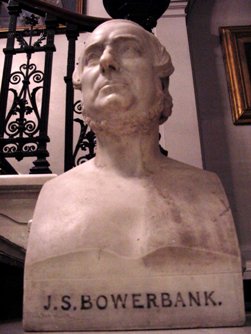
Geologist and Science writer Nina Morgan contemplates an unusual menu
The son of a Wealthy merchant and distiller, and a keen collector of plants with a strong interest in geology, James Scott Bowerbank (1797 – 1877) accumulated a large collection of British fossils. He used these in his own studies in palaeobotany and sponges, but was also happy to make them available to other researchers. The ‘palaeontological soirées’ held at his home led to the formation of the London Clay Club, in which members devoted themselves to studying London Clay fossils, and making a complete list of the species. In 1847, in the tea-room at the Geological Society, Bowerbank proposed the formation of a society to publish undescribed British fossils. This became known as the Palaeontographical Society.
Image : Bust of Bowerbank by Peter Slater (1865, exhibited at the RA in 1866), Burlington House.
Amateurs, too, benefited from his generous nature. “From 1844-1864 Dr Bowerbank was in the habit of receiving once a week, at his residence in Park Street, and afterwards at Highbury Grove”, recalled an anonymous obituarist writing in the Geological Magazine. “On these occasions every youthful geological student found in him a willing instructor and a sincere and kind friend. The treasures of his Museum, the use of his microscopes, and his personal assistance were at the disposal of every one.”
The published fruits of Bowerbank’s studies included A History of Fossil Fruits and Seeds of the London Clay. With illustrations by James De Carle Sowerby, the book made a big impact in the scientific society of the day. “The author is entitled to great praise in undertaking the illustration of one of the most difficult and important departments of fossil botany” gushed a reviewer writing in Annals and Magazine of Natural History in 1840: “and we trust that he may be encouraged to continue his researches in a subject so replete with interest, and in the prosecution of which he has already displayed so much zeal and ability.”
The book also brought Bowerbank to the attention of a public with a taste for palaeontology. It even inspired a popular cartoon illustrating delicacies on offer at the ‘Dinotherium Dining Rooms’, located next to the’ Megatherium Mansion, the Daily House in London for Antediluvium Grub’. As well as 80,000,000 New Fossil Fruits, and sponge cake (Bowerbank was also a keen collector of fossil sponges), diners were offered choices such as Haunch of Mastodon and Real Fossil Turtle soup.
Although fossil food is no longer offered on any menu today, you can still feast your eyes on – or drink your coffee from – a copy of the original lithograph. The Science and Society Picture Library is just one of the outlets that sells copies of it. Their menu includes prints, postcards and greetings cards and coffee mugs – all at very reasonable prices. Just the thing to tempt the appetite.
*Nina Morgan is a geologist and science writer based near Oxford.
Acknowledgment
Some early collectors and collections of fossil sponges represented in the Natural History Museum London, by Sarah Long, Paul Taylor, Steve Baker and John Cooper, published in 2003, in The Geological Curator, 7(10), pp. 353-362; The obituary of James Scott Bowerbank FRS FLS FGS President of the Palaeontographical Society, published in the Geological Magazine, Decade 2, vol 4, pp. 191-2; and information about the print that appears on the website www.ssplprints.com/image/105114/unattributed-highbury-grove-in-1846. Thanks also to Eric Robinson, for sending me a copy of the lithograph that inspired this vignette.
- If the past is the key to your present interests, why not join the History of Geology Group (HOGG)? For more information and to read the latest HOGG newsletter, visit: www.geolsoc.org.uk/hogg, where the programme and abstracts from the Conference on Geological Collectors and Collecting are available as a pdf file free to download.